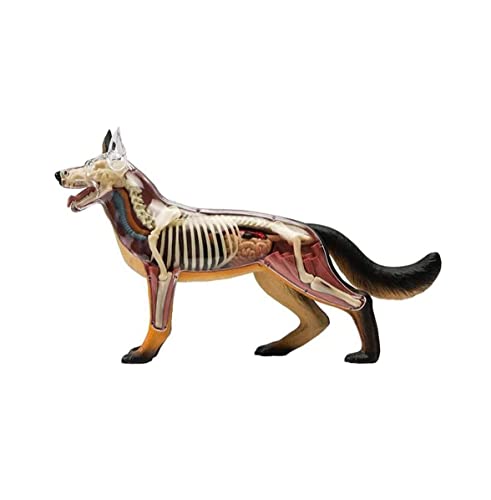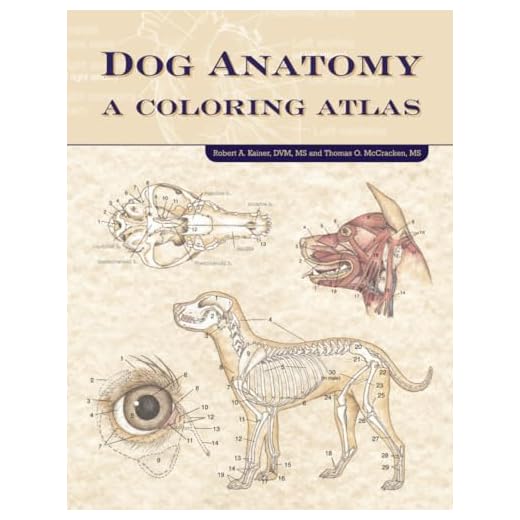




To truly appreciate the anatomy of a canine, one must examine the intricate framework that supports its form. The skeletal system comprises approximately 319 bones, varying slightly by breed. Understanding this structure not only unveils the physical capabilities of these animals but also enriches our bond with them.
Each section of the skeleton serves a distinct function, contributing to the overall agility and endurance of a canine. For instance, the skull houses the brain and sensory organs, while a flexible spine allows for swift movements and impressive agility. The limb bones, particularly the femur and radius, are designed to bear weight and absorb shock during activities like running and jumping.
As I observed my own pet, I couldn’t help but marvel at the efficiency of its build. The powerful limbs and sturdy joints enable quick sprints, while the ribcage provides protection to vital organs. Engaging with a veterinarian or a canine anatomy expert can offer further insights into how these structures work harmoniously to support the lifestyle of our furry companions.
Visualising this framework can enhance your understanding of your pet’s health. If you notice changes in behaviour or mobility, examining the underlying skeletal structure might reveal important information. Regular check-ups can help ensure that all is well, keeping our beloved companions active and happy.
Understanding the Structure of a Canine Framework
A canine framework consists of approximately 319 bones, varying slightly depending on the breed. The cranial region features a complex arrangement of bones, including the skull, which houses the brain and protects it from external forces. The jaw consists of robust mandibles, enabling powerful bites. The vertebral column, comprising cervical, thoracic, lumbar, sacral, and caudal regions, supports both movement and posture.
Forelimb and Hindlimb Anatomy
The forelimbs are structured for both mobility and strength, showcasing a blend of humerus, radius, and ulna. Their joint configurations permit a wide range of motion, essential for running and playing. The hind limbs consist of femur, patella, tibia, and fibula, designed for propulsion. The unique structure of the joints, including stifles and hocks, allows for agility and stability.
Rib Cage and Pelvis Details
The rib cage, formed by the thoracic vertebrae and ribs, protects vital organs while allowing for respiration. The pelvis connects the hind limbs to the vertebral column, providing a sturdy base for movement. Its shape varies among breeds, influencing overall mobility and agility. Understanding these specifics can enhance knowledge of canine health and behaviour.
Overview of Canine Skeletal Structure
The skeletal framework of canines comprises approximately 319 bones, although this number may vary slightly depending on breed and individual traits. The primary components include the axial skeleton and the appendicular skeleton. The axial skeleton encompasses the skull, vertebral column, and ribcage, while the appendicular skeleton consists of the limbs and their associated girdles.
The skull is uniquely shaped to accommodate powerful jaws and a keen sense of smell. It houses 42 teeth in adults, enabling effective chewing and processing of food. The vertebral column is segmented into cervical, thoracic, lumbar, sacral, and caudal regions, providing flexibility and support for movement. Each vertebra is interconnected, allowing for a wide range of motion while maintaining stability.
The ribcage, formed by the ribs and sternum, protects vital organs such as the heart and lungs, while also playing a role in respiratory function. The appendicular skeleton features forelimbs and hind limbs, with each limb comprising a series of bones: humerus and radius in the front, and femur and tibia in the back. The structure of these limbs is designed for agility and strength, allowing for running, jumping, and playing.
Joints, including the elbow and knee, are crucial for mobility, allowing flexibility and support during activities. Ligaments and tendons connect bones to each other and muscles to bones, respectively, playing a pivotal role in movement and stability. Understanding this anatomical arrangement provides insight into the remarkable agility and strength of these companions.
Furthermore, the unique traits of different breeds can influence skeletal structure, such as variations in size and shape. Smaller breeds may have a more delicate framework, while larger breeds exhibit robust bone density. Observing these differences can enhance appreciation for the diversity within canine physiology.
Key Differences Between Canine and Human Structures
Understanding the contrasts between these two frameworks is fascinating. The primary distinction lies in the number of bones; canines typically have around 319, while humans possess 206. This variance arises from the presence of additional tail vertebrae and a slightly different arrangement in the limbs of canines.
Limb Structure
The forelimbs of canines are adapted for running, featuring a more elongated radius and ulna. This design allows for greater speed and agility. In contrast, human arms are structured for dexterity, with a more flexible wrist and opposable thumbs, enabling intricate movements.
Skull Differences
The cranial structure is another area of divergence. Canines have a more elongated snout, which houses a larger olfactory bulb for heightened sense of smell. The jaw structure also differs; canine jaws are designed for gripping and tearing, while the human jaw is suited for grinding and chewing, reflecting dietary needs.
Main Bones in a Canine Framework
The framework of a canine includes several key structures that serve crucial functions in mobility and support. The primary components are the skull, vertebral column, ribs, and limbs. Understanding these bones offers insight into how our furry companions move and interact with their environment.
Skull and Facial Structure
The skull houses the brain and protects it from injury. It comprises numerous bones fused together, including the maxilla and mandible, which form the jaw. The shape of the skull varies across breeds, influencing factors like bite strength and facial expression. Notably, the occipital bone connects to the spine, facilitating head movement.
Limbs and Their Role
The forelimbs consist of the humerus, radius, and ulna, while the hind limbs include the femur, tibia, and fibula. These bones work together to provide strength and flexibility. The carpal and tarsal bones in the wrists and ankles allow for complex movements. Ligaments and tendons attach muscles to these bones, enabling powerful leaps and swift runs.
Understanding these structures not only helps in appreciating the anatomy of canines but also aids in recognising health issues that may arise in their framework. Regular check-ups can ensure that their bones remain strong and healthy, allowing them to enjoy an active life.
Understanding the Function of Each Bone
Focusing on the roles played by individual bones reveals fascinating insights into how these structures support life and movement in canines. Each bone serves a specific purpose, contributing to the animal’s overall functionality.
| Bone | Function |
|---|---|
| Skull | Protects the brain and houses sensory organs, critical for processing information from the environment. |
| Vertebrae | Forms the spinal column, providing support and flexibility while protecting the spinal cord. |
| Ribs | Encases vital organs within the chest, aiding in respiration by allowing the lungs to expand and contract. |
| Pelvis | Connects the hind limbs to the body, supporting weight and allowing for movement and stability. |
| Femur | Acts as the primary bone of the hind leg, enabling powerful propulsion during running and jumping. |
| Tibia and Fibula | Support the lower leg, facilitating movement and weight distribution. |
| Radius and Ulna | Form the forearm, allowing for the flexibility and strength needed for digging and playing. |
| Carpals, Metacarpals, and Phalanges | Make up the paw structure, providing dexterity and grip while navigating various terrains. |
Observing these bones in action showcases their remarkable adaptations for various activities. For instance, the femur’s length and strength are ideal for sprinting, while the flexibility in the wrist bones allows for agile movements. Understanding these functions deepens appreciation for the anatomy and capabilities of our furry companions.
Common Skeletal Disorders in Canines
Regular veterinary check-ups are crucial for early detection of skeletal issues in pets. Conditions such as hip dysplasia, osteoarthritis, and patellar luxation often go unnoticed until significant damage occurs. Ensure your companion maintains a healthy weight; excess pounds can exacerbate joint problems. A balanced diet rich in omega fatty acids can also support joint health.
Hip Dysplasia
This genetic disorder affects the hip joint, causing pain and mobility issues. Signs include difficulty rising, reluctance to exercise, and a noticeable limp. If you notice any of these symptoms, consult a veterinarian for potential treatment options, including medication or surgical intervention. Early diagnosis can significantly improve the quality of life.
Osteoarthritis
A degenerative joint disease that is common in ageing animals. Symptoms include stiffness, swelling, and decreased activity levels. Regular, low-impact exercise can help manage this condition. Physical therapy and weight management also play a significant role in alleviating discomfort. Supplements like glucosamine may provide additional support.
How to Care for a Canine’s Skeletal Health
Regular exercise is key. Taking your furry friend out for daily walks or engaging in playtime activities helps maintain strong bones and joints. Aim for at least 30 minutes of moderate activity each day.
Nutrition Matters
A balanced diet rich in calcium and phosphorus is crucial for bone health. Consider the following:
- High-quality commercial dog food that meets AAFCO standards.
- Incorporating fresh vegetables like broccoli and carrots.
- Consulting with a veterinarian about supplements, especially for older pets.
Regular Veterinary Check-ups
Annual check-ups can catch potential skeletal issues early. During these visits, your vet will:
- Assess weight, as obesity can strain bones and joints.
- Examine for any signs of discomfort or mobility issues.
- Recommend appropriate vaccinations and preventive care.
Pay attention to your companion’s behaviour. If they show reluctance to jump, play, or run, it may indicate underlying skeletal concerns. Always act on these signs promptly.
Resources for Further Learning About Canine Anatomy
For those keen on expanding their knowledge of canine anatomy and health, several resources are invaluable. Here’s a curated list that can enhance your understanding and care for our furry friends.
Books
- Dog Anatomy: A Pictorial Approach to Understanding the Canine Body by Robert K. Anderson – This book provides detailed illustrations and explanations of the structure and function of canine anatomy.
- The Dog Anatomy Workbook by Susan A. Smith – An interactive guide with diagrams and exercises that allow for hands-on learning.
- Canine Sports Medicine and Surgery by Darryl Millis and Scott M. Hoffer – A comprehensive resource for understanding anatomy in relation to sports and physical activity.
Online Courses
- Canine Anatomy and Physiology Course – A detailed online course that covers all aspects of dog anatomy.
- Understanding Canine Behaviour – While focused on behaviour, this course includes anatomical insights that affect movement and health.
For pet owners facing specific health challenges, such as heart conditions, knowing the right nutrition is crucial. You can find the best food to feed a dog with congestive heart failure to support overall health.
Utilising these resources will deepen your comprehension of canine anatomy and contribute to better care for your pet.









